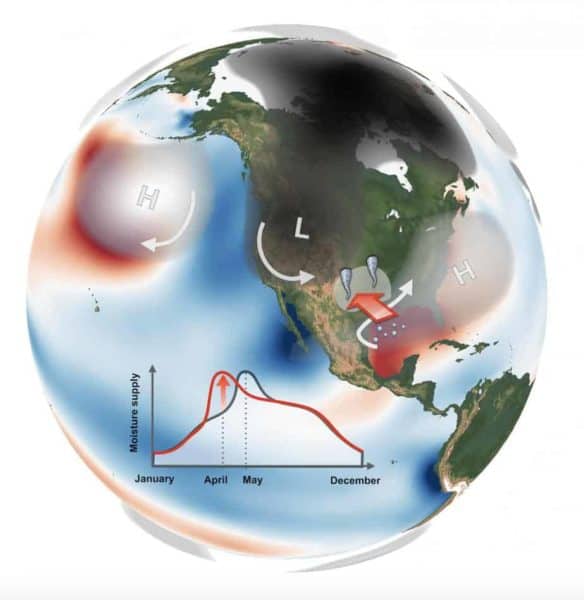New research, published in the journal Science Advances, has found that unusual ocean temperatures in the tropical Pacific and Atlantic can drastically increase April tornado occurrences over the Great Plains region of the United States.
2019 has seen the second highest number of January to May tornadoes in the United States since 2000, with several deadly outbreaks claiming more than 38 fatalities. Why some years are very active, whereas others are relatively calm, has remained an unresolved mystery for scientists and weather forecasters.
Climate researchers from the IBS Center for Climate Physics (ICCP), South Korea have found new evidence implicating a role for ocean temperatures in US tornado activity, particularly in April. Analyzing a large number of atmospheric data and climate computer model experiments, the scientists discovered that a cold tropical Pacific and/or a warm Gulf of Mexico are likely to generate large-scale atmospheric conditions that enhance thunderstorms and a tornado-favorable environment over the Southern Great Plains.
This particular atmospheric situation, with alternating high- and low-pressure centers located in the central Pacific, Eastern United States and over the Gulf of Mexico, is known as the negative Pacific North America (PNA) pattern (Figure 1). According to the new research, ocean temperatures can boost this weather pattern in April. The corresponding high pressure over the Gulf of Mexico then funnels quickly-rotating moist air into the Great Plains region, which in turn fuels thunderstorms and tornadoes.
“Previous studies have overlooked the temporal evolution of ocean-tornado linkages. We found a clear relationship in April, but not in May “, says Dr. Jung-Eun Chu, lead author of the study and research fellow at the ICCP.
“Extreme tornado occurrences in the past, such as those in April 2011, were consistent with this blueprint. Cooler than normal conditions in the tropical Pacific and a warm Gulf of Mexico intensify the negative PNA, which then turbocharges the atmosphere with humid air and more storm systems”, explains Axel Timmermann, Director of the ICCP and Professor at Pusan National University.
“Seasonal ocean temperature forecasts for April, which many climate modeling centers issue regularly, may further help in predicting the severity of extreme weather conditions over the United States”, says June-Yi Lee, Professor at Pusan National University and Coordinating Lead Author of the 6th Assessment report of the Intergovernmental Panel on Climate Change.
“How Global Warming will influence extreme weather over North America, including tornadoes still remains unknown “, says. Dr. Chu. To address this question, the researchers are currently conducting ultra-high-resolution supercomputer simulations on the institute’s new supercomputer Aleph.


